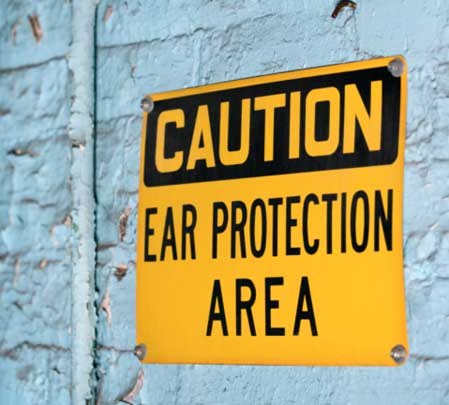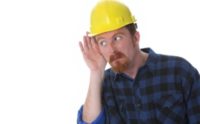 Even a low level of noise can be hazardous to the human ear and may have serious consequences, e.g. loss of hearing. Earplugs and other devices can prevent this and there are now apps to measure the noise level and obtain recommendations on appropriate hearing protection. The complete range of innovations in hearing protection on the personal protective equipment (PPE) market can soon be viewed at A+A 2017, the leading trade fair and congress on occupational health and safety held in Düsseldorf, Germany from October 17 – 20, 2017.
Even a low level of noise can be hazardous to the human ear and may have serious consequences, e.g. loss of hearing. Earplugs and other devices can prevent this and there are now apps to measure the noise level and obtain recommendations on appropriate hearing protection. The complete range of innovations in hearing protection on the personal protective equipment (PPE) market can soon be viewed at A+A 2017, the leading trade fair and congress on occupational health and safety held in Düsseldorf, Germany from October 17 – 20, 2017.
Let’s start with the good news: “When it comes to the damage a person can suffer from a noisy workplace, there has been an increasing awareness recently,” says Manfred Schuster, head of Hearing Protection at Uvex, one of around 1,900 exhibitors at A+A 2017. To reduce potential hazards, the safety engineers of companies are in close contact with manufacturers. This has also been confirmed by Joao Rosario, application engineer in the Personal Safety Division of the multi-technology group 3M, another company represented at A+A 2017. Rosario believes that this is important because “although medicine has made amazing progress in the treatment of hearing damage in recent years, it’s impossible to eliminate all hearing problems.” Preventative healthcare therefore continues to be vital, and so does the use of personal protection equipment. The latest technologies and most effective products on the market will be shown by leading suppliers at A+A 2017 and will also be highlighted at the accompanying congress, where PPE is traditionally a major topic.
What is true for clothing is also true for hearing protection, i.e. that the protection of the workforce is gaining in significance, partly due to demographic change and partly to shortages of skilled staff. It’s important to protect every single staff member and to ensure their corporate loyalty for as long as possible. Moreover, young people, in particular, tend to underestimate the hazards caused by noise. “This puts them especially at risk,” says Rosario, as they usually only react quickly if they experience acute hearing loss, caused by excessive noise. It often takes 10 to 20 years before people become aware of any long-term damage.
Yet a person’s hearing is not the only thing that is affected by noise. Noise can cause stress to the entire human organism. It has a subconscious impact on the whole body, causing poor concentration, gastrointestinal disorders and high blood pressure. It can even increase the risk of a heart attack. There is generally a wider awareness of noise hazards now, and as employees are very interested in protecting themselves, they are grateful to their employers if the issue is handled proactively and professionally. The new PPE regulation has added further weight to noise-induced hearing loss as today’s most widely recognized occupational disease.
Noise involves major risks
One issue, in particular, is currently attracting attention among suppliers in the industry: the new European PPE Regulation 2016/425. This new legislation, which has been in effect since April 2016, puts hazardous noise in Category III, i.e. “risks that may cause very serious consequences such as death or irreversible damage to health”. Manufacturers must therefore have their ear protection products checked for conformity on an annual basis, whereas, until recently, it was sufficient to have a renewed inspection five years after receiving an EU type examination certificate. The purpose of this new law is to increase safety for wearers. “Nothing much has changed for us,” says Manfred Schuster from Uvex. “We obtain our plastics from A-suppliers whom we see as strategic partners. They, too, have to submit to continuous checking by external bodies. Like most German PPE manufacturers, Uvex believes that it is part of their everyday business to exceed the expected standards. Incoming goods are therefore spot-checked on a regular basis.
The downside of the new regulation is that procurement has become more expensive, and indeed in a market which is cost-conscious even though people are more aware of their need for protection. The new regulation even specifies the format of operating instructions. Similar to a patient leaflet for a pharmaceutical product, these instructions now need to be provided in a precisely specified paper size, with comprehensive details in a certain font size, in 27 languages and also even for very small packages. This is to ensure that hearing protection is correctly applied and cared for.
Different noisy environments
One major practical challenge is the variety of noise levels in the working environment. “As working conditions change,” says Joao Rosario from 3M, “it becomes more and more important to use hearing protection which is suitable for a variety of noisy environments.” The technology group has developed earplugs where users can toggle between a higher and lower level of protection, while also being protected against impulse noise – i.e. short sudden burst of noise – at both levels.
Although efforts are continually in progress to reduce machine noise, some industrial work is still extremely noisy, e.g. demolition jobs and any work that involves metalworking and woodworking equipment. But even the “pleasant noise” of a band or orchestra can have a detrimental effect on the listener’s health. The most reasonably priced way for protection is to use a pair of simple foam earplugs, made, for instance, by Honeywell, Uvex and 3M – all of them exhibitors A+A 2017. Yet although this form of PPE protects the wearer against the damaging power of noise, created by air pressure in the ear, the noise is still perceived in a distorted form.
One alternative to ready-to-use earplugs is ear molds that can be individually adjusted. They are made, for instance, by Elacin Hearing Protection from the Netherlands, another company at A+A 2017. With this form of hearing protection the emphasis is on both speech intelligibility and high wearing comfort. This kind of specially customized hearing protection can now be manufactured in a 3D printing process at a millimeter accuracy. Nevertheless, the devices still need to be checked, both at delivery and then at regular intervals, to make sure they maintain their protective function and also to prevent any pressure that might result from frequent head movements.
Smart hearing protection
A hearing protection product that is currently gaining in popularity is one that can be used, for instance, in conjunction with a smartphone, when listening to music or making phone calls. For certain professional groups, such as wind turbine mechanics and forestry workers, it is important to stay in touch with colleagues across distances. This, too, can be ensured through active hearing protection.
Another area which is receiving more and more attention is earplugs, earmuffs and hearing aids with miniature batteries. They can deliver, for instance, level-dependent attenuation while also amplifying very low noises – a useful feature for military purposes. Such a smart hearing protection and communication system is offered, for instance, by Honeywell, a leading supplier of protective clothing. Honeywell will also present its product range of protective clothing and contamination protection at A+A 2017. Overall, some 120 hearing protection suppliers will showcase their latest trends and innovations for personal protection, corporate safety and a healthy workplace at the upcoming trade fair.
The more complex and expensive the hearing protection, the more there is a demand for accessories. “Hygiene sets, for instance, play a major role – both in passive and active earmuffs,” says Joao Rosario. “Active hearing protection involves accessories such as wind protection for microphones, rechargeable batteries and rechargers.” All accessories are of a high quality, offering increasingly smart solutions. “Electronic hearing protection,” says Manfred Schuster, “can now be provided with packaging that has integrated rechargers.”
Apart from functionality, training is another important factor in hearing protection. The right kind of protection can be identified, and information can be obtained on the appropriate use of equipment. Uvex puts up small stands in its customer company’s cafeterias to provide information on this subject which tends to be underestimated. In addition to obtaining advice and training on their own premises, safety engineers can also receive CPD at the Uvex Academy or at 3M, where special courses are offered for professionals.
Using an app to measure noise
The two A+A exhibitors 3M and Uvex each have a decibel app which users can use on their smartphones to decide whether they ought to wear hearing protection. Appropriate noise protection options are then presented in the form of a color scale. Green means that no protection is needed, yellow that it is mandatory, and red that protection must be specially adjusted to suit high- or medium-frequency noise. Then the app recommends suitable products. It is also a simple way to sharpen one’s sensitivity to noise and to assess the potential hazards correctly.
Up-to-date details about A+A 2017 and its exhibitors, (hearing protection suppliers) are available at www.aplusa-online.com.
* Ear molds are more comfortable to wear for long periods of time, because they can be individually adjusted. * Clamp ear protectors (available as in-ear or on-ear products) are suitable for anyone having to or wanting remove them at frequent intervals. Whenever the wearer doesn’t need them, they can put them round their neck like a pair of headphones. * Earmuffs are suitable for short jobs in noisy environments. If the noise level is extreme, they can also be combined with earplugs. The lighter they are, the more pleasant they are to wear.


